Examining COPD in America: Incidence, Social Factors, and Nursing
VerifiedAdded on 2022/08/23
|8
|2536
|21
Report
AI Summary
This report provides a detailed analysis of Chronic Obstructive Pulmonary Disease (COPD) in the United States, highlighting its incidence, social determinants, and the crucial role of primary care nurses in addressing this significant public health issue. The report begins by defining COPD and its impact, noting its status as a leading cause of death in America, and then delves into the social determinants of health, such as socioeconomic status, race, ethnicity, and access to healthcare, which contribute to health disparities and increased COPD prevalence among vulnerable populations. Epidemiological studies are reviewed to understand the prevalence of COPD across different demographics, emphasizing the need for interventions that are not gender-specific. The report further emphasizes the role of primary care nurses in bridging communication gaps, ensuring cultural competence, and providing patient education for self-management, concluding that addressing COPD requires a multi-faceted approach focusing on social justice, equal resource distribution, and culturally sensitive healthcare practices to alleviate the economic and social burden of COPD in the U.S. healthcare system. Desklib offers a wealth of similar solved assignments and study resources for students.
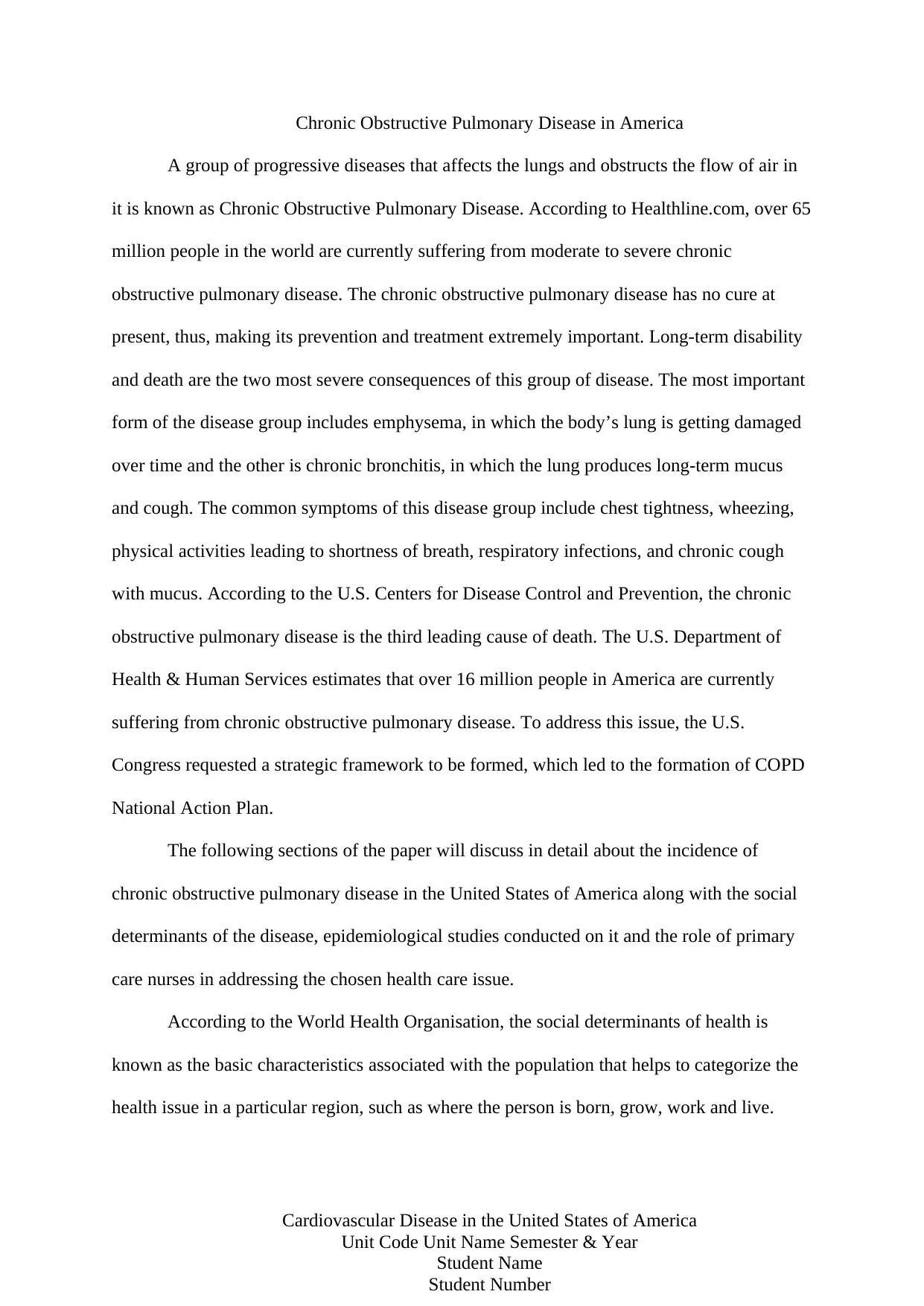
Chronic Obstructive Pulmonary Disease in America
A group of progressive diseases that affects the lungs and obstructs the flow of air in
it is known as Chronic Obstructive Pulmonary Disease. According to Healthline.com, over 65
million people in the world are currently suffering from moderate to severe chronic
obstructive pulmonary disease. The chronic obstructive pulmonary disease has no cure at
present, thus, making its prevention and treatment extremely important. Long-term disability
and death are the two most severe consequences of this group of disease. The most important
form of the disease group includes emphysema, in which the body’s lung is getting damaged
over time and the other is chronic bronchitis, in which the lung produces long-term mucus
and cough. The common symptoms of this disease group include chest tightness, wheezing,
physical activities leading to shortness of breath, respiratory infections, and chronic cough
with mucus. According to the U.S. Centers for Disease Control and Prevention, the chronic
obstructive pulmonary disease is the third leading cause of death. The U.S. Department of
Health & Human Services estimates that over 16 million people in America are currently
suffering from chronic obstructive pulmonary disease. To address this issue, the U.S.
Congress requested a strategic framework to be formed, which led to the formation of COPD
National Action Plan.
The following sections of the paper will discuss in detail about the incidence of
chronic obstructive pulmonary disease in the United States of America along with the social
determinants of the disease, epidemiological studies conducted on it and the role of primary
care nurses in addressing the chosen health care issue.
According to the World Health Organisation, the social determinants of health is
known as the basic characteristics associated with the population that helps to categorize the
health issue in a particular region, such as where the person is born, grow, work and live.
Cardiovascular Disease in the United States of America
Unit Code Unit Name Semester & Year
Student Name
Student Number
A group of progressive diseases that affects the lungs and obstructs the flow of air in
it is known as Chronic Obstructive Pulmonary Disease. According to Healthline.com, over 65
million people in the world are currently suffering from moderate to severe chronic
obstructive pulmonary disease. The chronic obstructive pulmonary disease has no cure at
present, thus, making its prevention and treatment extremely important. Long-term disability
and death are the two most severe consequences of this group of disease. The most important
form of the disease group includes emphysema, in which the body’s lung is getting damaged
over time and the other is chronic bronchitis, in which the lung produces long-term mucus
and cough. The common symptoms of this disease group include chest tightness, wheezing,
physical activities leading to shortness of breath, respiratory infections, and chronic cough
with mucus. According to the U.S. Centers for Disease Control and Prevention, the chronic
obstructive pulmonary disease is the third leading cause of death. The U.S. Department of
Health & Human Services estimates that over 16 million people in America are currently
suffering from chronic obstructive pulmonary disease. To address this issue, the U.S.
Congress requested a strategic framework to be formed, which led to the formation of COPD
National Action Plan.
The following sections of the paper will discuss in detail about the incidence of
chronic obstructive pulmonary disease in the United States of America along with the social
determinants of the disease, epidemiological studies conducted on it and the role of primary
care nurses in addressing the chosen health care issue.
According to the World Health Organisation, the social determinants of health is
known as the basic characteristics associated with the population that helps to categorize the
health issue in a particular region, such as where the person is born, grow, work and live.
Cardiovascular Disease in the United States of America
Unit Code Unit Name Semester & Year
Student Name
Student Number
Paraphrase This Document
Need a fresh take? Get an instant paraphrase of this document with our AI Paraphraser
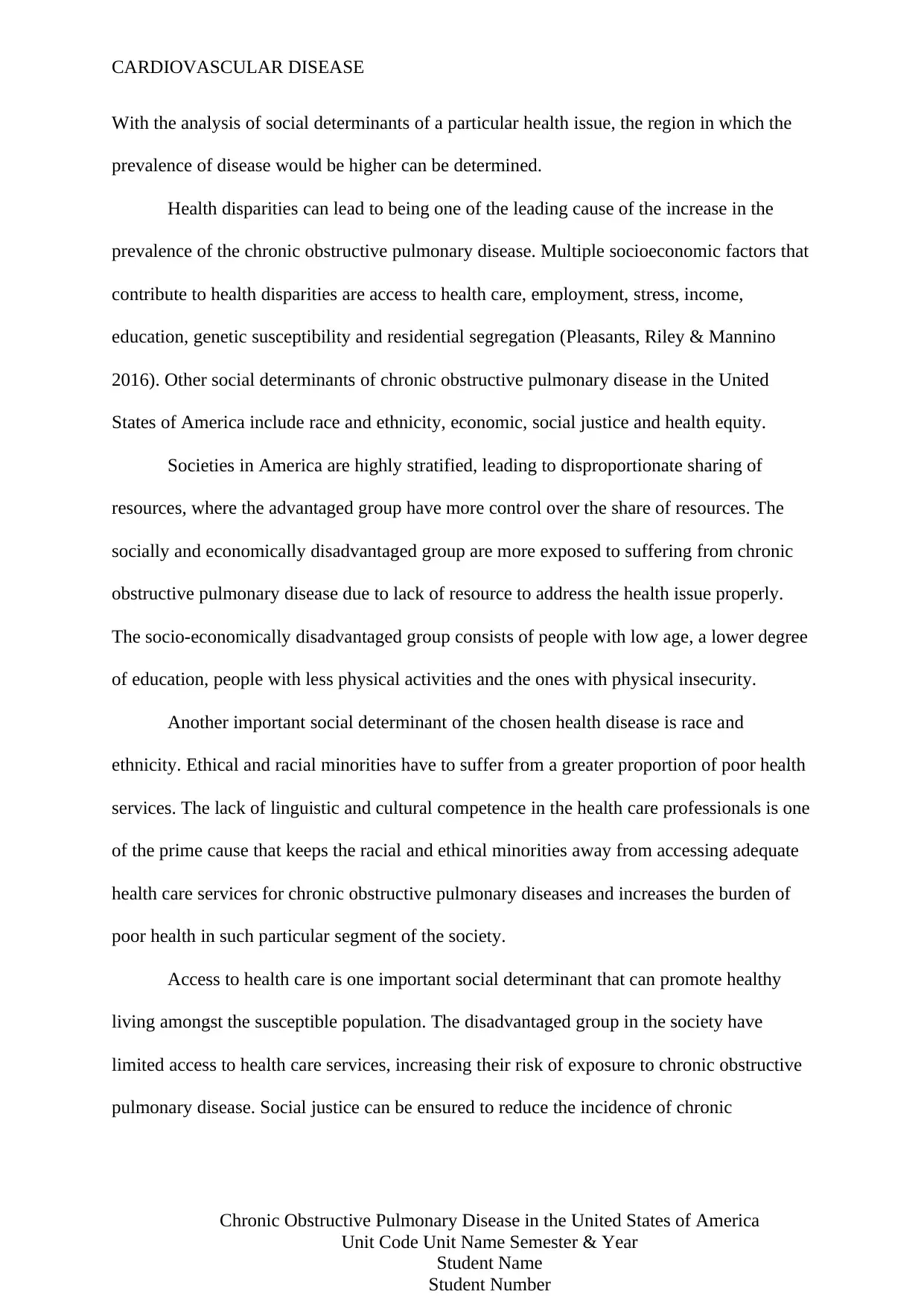
CARDIOVASCULAR DISEASE
With the analysis of social determinants of a particular health issue, the region in which the
prevalence of disease would be higher can be determined.
Health disparities can lead to being one of the leading cause of the increase in the
prevalence of the chronic obstructive pulmonary disease. Multiple socioeconomic factors that
contribute to health disparities are access to health care, employment, stress, income,
education, genetic susceptibility and residential segregation (Pleasants, Riley & Mannino
2016). Other social determinants of chronic obstructive pulmonary disease in the United
States of America include race and ethnicity, economic, social justice and health equity.
Societies in America are highly stratified, leading to disproportionate sharing of
resources, where the advantaged group have more control over the share of resources. The
socially and economically disadvantaged group are more exposed to suffering from chronic
obstructive pulmonary disease due to lack of resource to address the health issue properly.
The socio-economically disadvantaged group consists of people with low age, a lower degree
of education, people with less physical activities and the ones with physical insecurity.
Another important social determinant of the chosen health disease is race and
ethnicity. Ethical and racial minorities have to suffer from a greater proportion of poor health
services. The lack of linguistic and cultural competence in the health care professionals is one
of the prime cause that keeps the racial and ethical minorities away from accessing adequate
health care services for chronic obstructive pulmonary diseases and increases the burden of
poor health in such particular segment of the society.
Access to health care is one important social determinant that can promote healthy
living amongst the susceptible population. The disadvantaged group in the society have
limited access to health care services, increasing their risk of exposure to chronic obstructive
pulmonary disease. Social justice can be ensured to reduce the incidence of chronic
Chronic Obstructive Pulmonary Disease in the United States of America
Unit Code Unit Name Semester & Year
Student Name
Student Number
With the analysis of social determinants of a particular health issue, the region in which the
prevalence of disease would be higher can be determined.
Health disparities can lead to being one of the leading cause of the increase in the
prevalence of the chronic obstructive pulmonary disease. Multiple socioeconomic factors that
contribute to health disparities are access to health care, employment, stress, income,
education, genetic susceptibility and residential segregation (Pleasants, Riley & Mannino
2016). Other social determinants of chronic obstructive pulmonary disease in the United
States of America include race and ethnicity, economic, social justice and health equity.
Societies in America are highly stratified, leading to disproportionate sharing of
resources, where the advantaged group have more control over the share of resources. The
socially and economically disadvantaged group are more exposed to suffering from chronic
obstructive pulmonary disease due to lack of resource to address the health issue properly.
The socio-economically disadvantaged group consists of people with low age, a lower degree
of education, people with less physical activities and the ones with physical insecurity.
Another important social determinant of the chosen health disease is race and
ethnicity. Ethical and racial minorities have to suffer from a greater proportion of poor health
services. The lack of linguistic and cultural competence in the health care professionals is one
of the prime cause that keeps the racial and ethical minorities away from accessing adequate
health care services for chronic obstructive pulmonary diseases and increases the burden of
poor health in such particular segment of the society.
Access to health care is one important social determinant that can promote healthy
living amongst the susceptible population. The disadvantaged group in the society have
limited access to health care services, increasing their risk of exposure to chronic obstructive
pulmonary disease. Social justice can be ensured to reduce the incidence of chronic
Chronic Obstructive Pulmonary Disease in the United States of America
Unit Code Unit Name Semester & Year
Student Name
Student Number
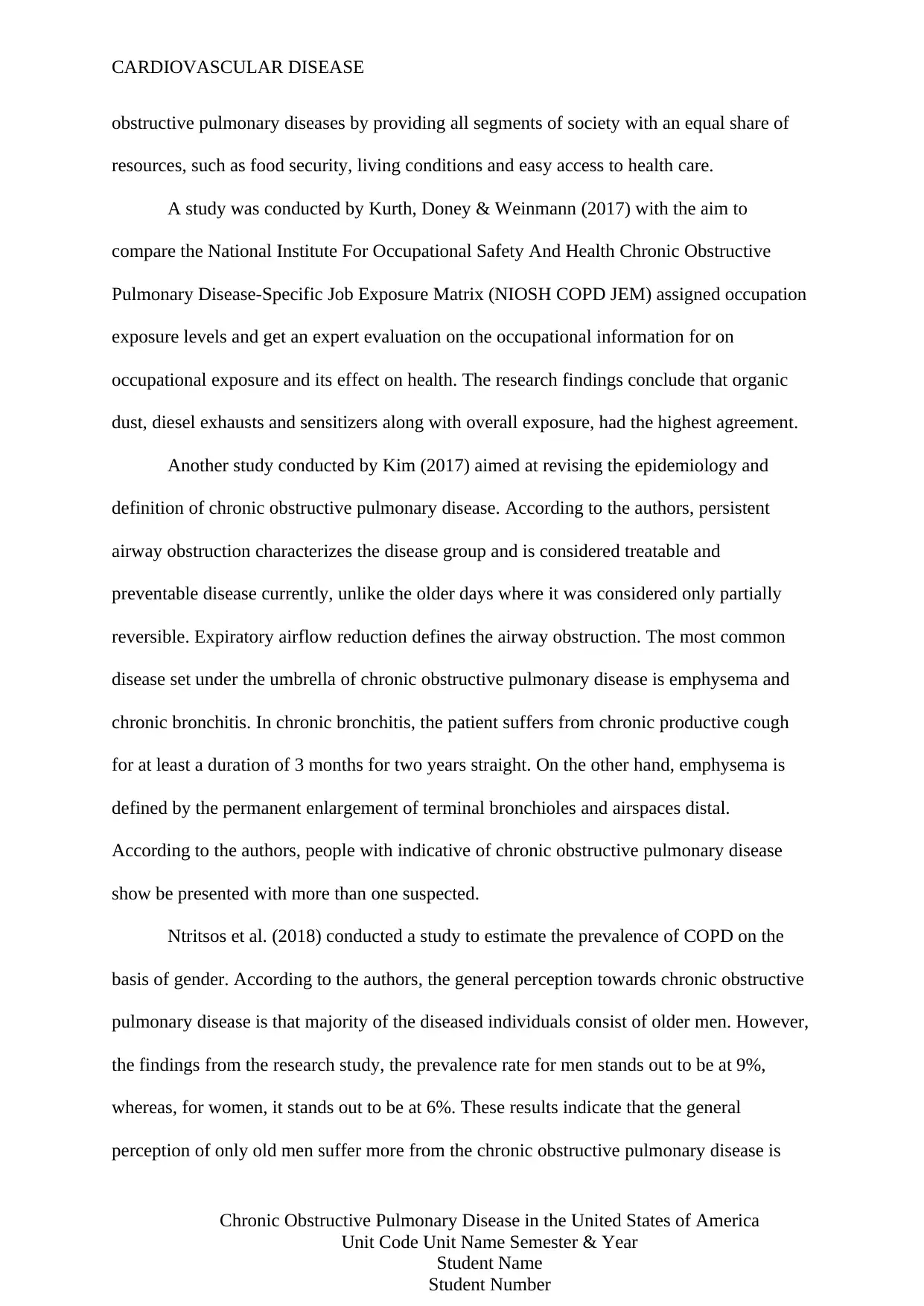
CARDIOVASCULAR DISEASE
obstructive pulmonary diseases by providing all segments of society with an equal share of
resources, such as food security, living conditions and easy access to health care.
A study was conducted by Kurth, Doney & Weinmann (2017) with the aim to
compare the National Institute For Occupational Safety And Health Chronic Obstructive
Pulmonary Disease-Specific Job Exposure Matrix (NIOSH COPD JEM) assigned occupation
exposure levels and get an expert evaluation on the occupational information for on
occupational exposure and its effect on health. The research findings conclude that organic
dust, diesel exhausts and sensitizers along with overall exposure, had the highest agreement.
Another study conducted by Kim (2017) aimed at revising the epidemiology and
definition of chronic obstructive pulmonary disease. According to the authors, persistent
airway obstruction characterizes the disease group and is considered treatable and
preventable disease currently, unlike the older days where it was considered only partially
reversible. Expiratory airflow reduction defines the airway obstruction. The most common
disease set under the umbrella of chronic obstructive pulmonary disease is emphysema and
chronic bronchitis. In chronic bronchitis, the patient suffers from chronic productive cough
for at least a duration of 3 months for two years straight. On the other hand, emphysema is
defined by the permanent enlargement of terminal bronchioles and airspaces distal.
According to the authors, people with indicative of chronic obstructive pulmonary disease
show be presented with more than one suspected.
Ntritsos et al. (2018) conducted a study to estimate the prevalence of COPD on the
basis of gender. According to the authors, the general perception towards chronic obstructive
pulmonary disease is that majority of the diseased individuals consist of older men. However,
the findings from the research study, the prevalence rate for men stands out to be at 9%,
whereas, for women, it stands out to be at 6%. These results indicate that the general
perception of only old men suffer more from the chronic obstructive pulmonary disease is
Chronic Obstructive Pulmonary Disease in the United States of America
Unit Code Unit Name Semester & Year
Student Name
Student Number
obstructive pulmonary diseases by providing all segments of society with an equal share of
resources, such as food security, living conditions and easy access to health care.
A study was conducted by Kurth, Doney & Weinmann (2017) with the aim to
compare the National Institute For Occupational Safety And Health Chronic Obstructive
Pulmonary Disease-Specific Job Exposure Matrix (NIOSH COPD JEM) assigned occupation
exposure levels and get an expert evaluation on the occupational information for on
occupational exposure and its effect on health. The research findings conclude that organic
dust, diesel exhausts and sensitizers along with overall exposure, had the highest agreement.
Another study conducted by Kim (2017) aimed at revising the epidemiology and
definition of chronic obstructive pulmonary disease. According to the authors, persistent
airway obstruction characterizes the disease group and is considered treatable and
preventable disease currently, unlike the older days where it was considered only partially
reversible. Expiratory airflow reduction defines the airway obstruction. The most common
disease set under the umbrella of chronic obstructive pulmonary disease is emphysema and
chronic bronchitis. In chronic bronchitis, the patient suffers from chronic productive cough
for at least a duration of 3 months for two years straight. On the other hand, emphysema is
defined by the permanent enlargement of terminal bronchioles and airspaces distal.
According to the authors, people with indicative of chronic obstructive pulmonary disease
show be presented with more than one suspected.
Ntritsos et al. (2018) conducted a study to estimate the prevalence of COPD on the
basis of gender. According to the authors, the general perception towards chronic obstructive
pulmonary disease is that majority of the diseased individuals consist of older men. However,
the findings from the research study, the prevalence rate for men stands out to be at 9%,
whereas, for women, it stands out to be at 6%. These results indicate that the general
perception of only old men suffer more from the chronic obstructive pulmonary disease is
Chronic Obstructive Pulmonary Disease in the United States of America
Unit Code Unit Name Semester & Year
Student Name
Student Number
⊘ This is a preview!⊘
Do you want full access?
Subscribe today to unlock all pages.

Trusted by 1+ million students worldwide
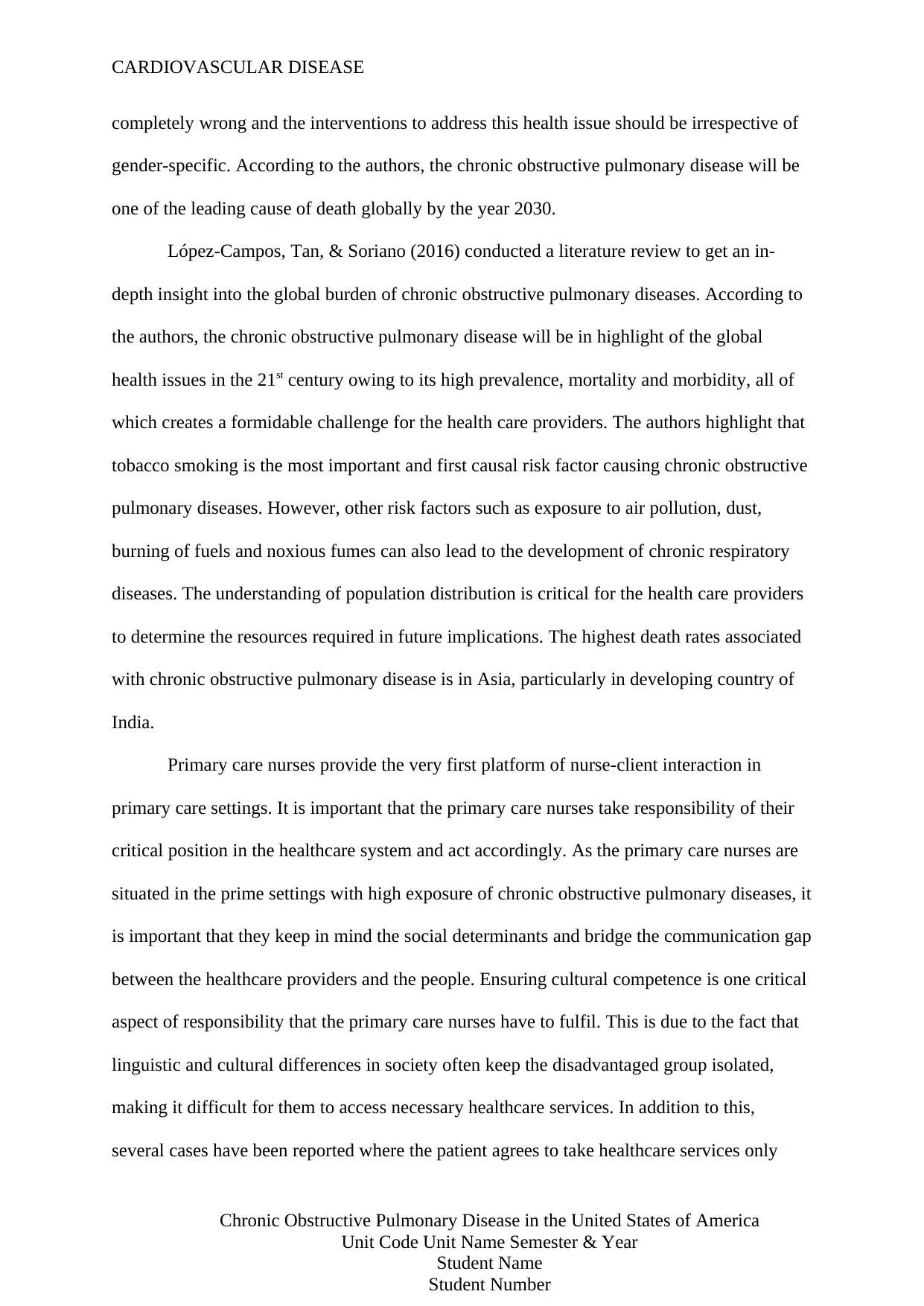
CARDIOVASCULAR DISEASE
completely wrong and the interventions to address this health issue should be irrespective of
gender-specific. According to the authors, the chronic obstructive pulmonary disease will be
one of the leading cause of death globally by the year 2030.
López‐Campos, Tan, & Soriano (2016) conducted a literature review to get an in-
depth insight into the global burden of chronic obstructive pulmonary diseases. According to
the authors, the chronic obstructive pulmonary disease will be in highlight of the global
health issues in the 21st century owing to its high prevalence, mortality and morbidity, all of
which creates a formidable challenge for the health care providers. The authors highlight that
tobacco smoking is the most important and first causal risk factor causing chronic obstructive
pulmonary diseases. However, other risk factors such as exposure to air pollution, dust,
burning of fuels and noxious fumes can also lead to the development of chronic respiratory
diseases. The understanding of population distribution is critical for the health care providers
to determine the resources required in future implications. The highest death rates associated
with chronic obstructive pulmonary disease is in Asia, particularly in developing country of
India.
Primary care nurses provide the very first platform of nurse-client interaction in
primary care settings. It is important that the primary care nurses take responsibility of their
critical position in the healthcare system and act accordingly. As the primary care nurses are
situated in the prime settings with high exposure of chronic obstructive pulmonary diseases, it
is important that they keep in mind the social determinants and bridge the communication gap
between the healthcare providers and the people. Ensuring cultural competence is one critical
aspect of responsibility that the primary care nurses have to fulfil. This is due to the fact that
linguistic and cultural differences in society often keep the disadvantaged group isolated,
making it difficult for them to access necessary healthcare services. In addition to this,
several cases have been reported where the patient agrees to take healthcare services only
Chronic Obstructive Pulmonary Disease in the United States of America
Unit Code Unit Name Semester & Year
Student Name
Student Number
completely wrong and the interventions to address this health issue should be irrespective of
gender-specific. According to the authors, the chronic obstructive pulmonary disease will be
one of the leading cause of death globally by the year 2030.
López‐Campos, Tan, & Soriano (2016) conducted a literature review to get an in-
depth insight into the global burden of chronic obstructive pulmonary diseases. According to
the authors, the chronic obstructive pulmonary disease will be in highlight of the global
health issues in the 21st century owing to its high prevalence, mortality and morbidity, all of
which creates a formidable challenge for the health care providers. The authors highlight that
tobacco smoking is the most important and first causal risk factor causing chronic obstructive
pulmonary diseases. However, other risk factors such as exposure to air pollution, dust,
burning of fuels and noxious fumes can also lead to the development of chronic respiratory
diseases. The understanding of population distribution is critical for the health care providers
to determine the resources required in future implications. The highest death rates associated
with chronic obstructive pulmonary disease is in Asia, particularly in developing country of
India.
Primary care nurses provide the very first platform of nurse-client interaction in
primary care settings. It is important that the primary care nurses take responsibility of their
critical position in the healthcare system and act accordingly. As the primary care nurses are
situated in the prime settings with high exposure of chronic obstructive pulmonary diseases, it
is important that they keep in mind the social determinants and bridge the communication gap
between the healthcare providers and the people. Ensuring cultural competence is one critical
aspect of responsibility that the primary care nurses have to fulfil. This is due to the fact that
linguistic and cultural differences in society often keep the disadvantaged group isolated,
making it difficult for them to access necessary healthcare services. In addition to this,
several cases have been reported where the patient agrees to take healthcare services only
Chronic Obstructive Pulmonary Disease in the United States of America
Unit Code Unit Name Semester & Year
Student Name
Student Number
Paraphrase This Document
Need a fresh take? Get an instant paraphrase of this document with our AI Paraphraser
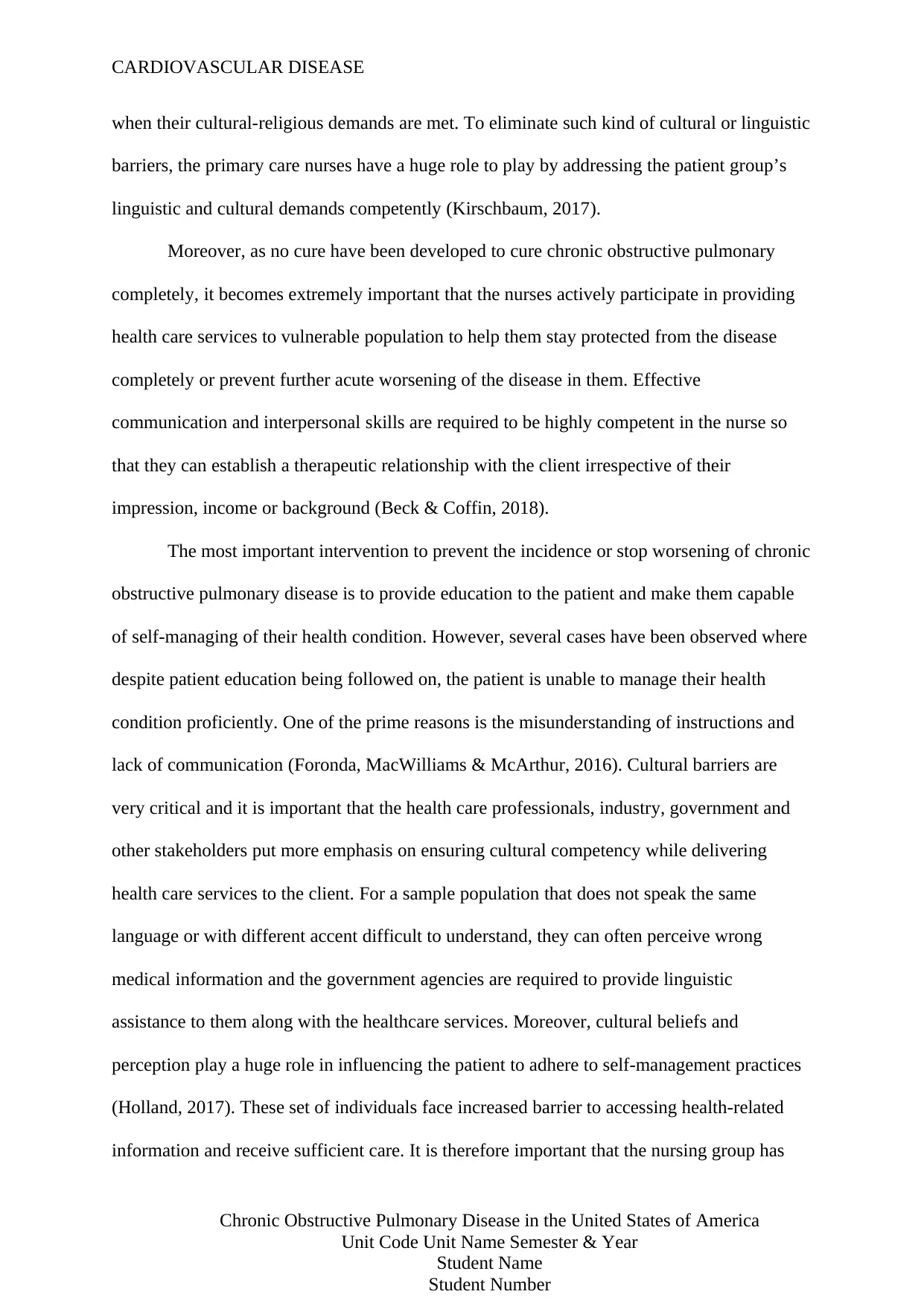
CARDIOVASCULAR DISEASE
when their cultural-religious demands are met. To eliminate such kind of cultural or linguistic
barriers, the primary care nurses have a huge role to play by addressing the patient group’s
linguistic and cultural demands competently (Kirschbaum, 2017).
Moreover, as no cure have been developed to cure chronic obstructive pulmonary
completely, it becomes extremely important that the nurses actively participate in providing
health care services to vulnerable population to help them stay protected from the disease
completely or prevent further acute worsening of the disease in them. Effective
communication and interpersonal skills are required to be highly competent in the nurse so
that they can establish a therapeutic relationship with the client irrespective of their
impression, income or background (Beck & Coffin, 2018).
The most important intervention to prevent the incidence or stop worsening of chronic
obstructive pulmonary disease is to provide education to the patient and make them capable
of self-managing of their health condition. However, several cases have been observed where
despite patient education being followed on, the patient is unable to manage their health
condition proficiently. One of the prime reasons is the misunderstanding of instructions and
lack of communication (Foronda, MacWilliams & McArthur, 2016). Cultural barriers are
very critical and it is important that the health care professionals, industry, government and
other stakeholders put more emphasis on ensuring cultural competency while delivering
health care services to the client. For a sample population that does not speak the same
language or with different accent difficult to understand, they can often perceive wrong
medical information and the government agencies are required to provide linguistic
assistance to them along with the healthcare services. Moreover, cultural beliefs and
perception play a huge role in influencing the patient to adhere to self-management practices
(Holland, 2017). These set of individuals face increased barrier to accessing health-related
information and receive sufficient care. It is therefore important that the nursing group has
Chronic Obstructive Pulmonary Disease in the United States of America
Unit Code Unit Name Semester & Year
Student Name
Student Number
when their cultural-religious demands are met. To eliminate such kind of cultural or linguistic
barriers, the primary care nurses have a huge role to play by addressing the patient group’s
linguistic and cultural demands competently (Kirschbaum, 2017).
Moreover, as no cure have been developed to cure chronic obstructive pulmonary
completely, it becomes extremely important that the nurses actively participate in providing
health care services to vulnerable population to help them stay protected from the disease
completely or prevent further acute worsening of the disease in them. Effective
communication and interpersonal skills are required to be highly competent in the nurse so
that they can establish a therapeutic relationship with the client irrespective of their
impression, income or background (Beck & Coffin, 2018).
The most important intervention to prevent the incidence or stop worsening of chronic
obstructive pulmonary disease is to provide education to the patient and make them capable
of self-managing of their health condition. However, several cases have been observed where
despite patient education being followed on, the patient is unable to manage their health
condition proficiently. One of the prime reasons is the misunderstanding of instructions and
lack of communication (Foronda, MacWilliams & McArthur, 2016). Cultural barriers are
very critical and it is important that the health care professionals, industry, government and
other stakeholders put more emphasis on ensuring cultural competency while delivering
health care services to the client. For a sample population that does not speak the same
language or with different accent difficult to understand, they can often perceive wrong
medical information and the government agencies are required to provide linguistic
assistance to them along with the healthcare services. Moreover, cultural beliefs and
perception play a huge role in influencing the patient to adhere to self-management practices
(Holland, 2017). These set of individuals face increased barrier to accessing health-related
information and receive sufficient care. It is therefore important that the nursing group has
Chronic Obstructive Pulmonary Disease in the United States of America
Unit Code Unit Name Semester & Year
Student Name
Student Number
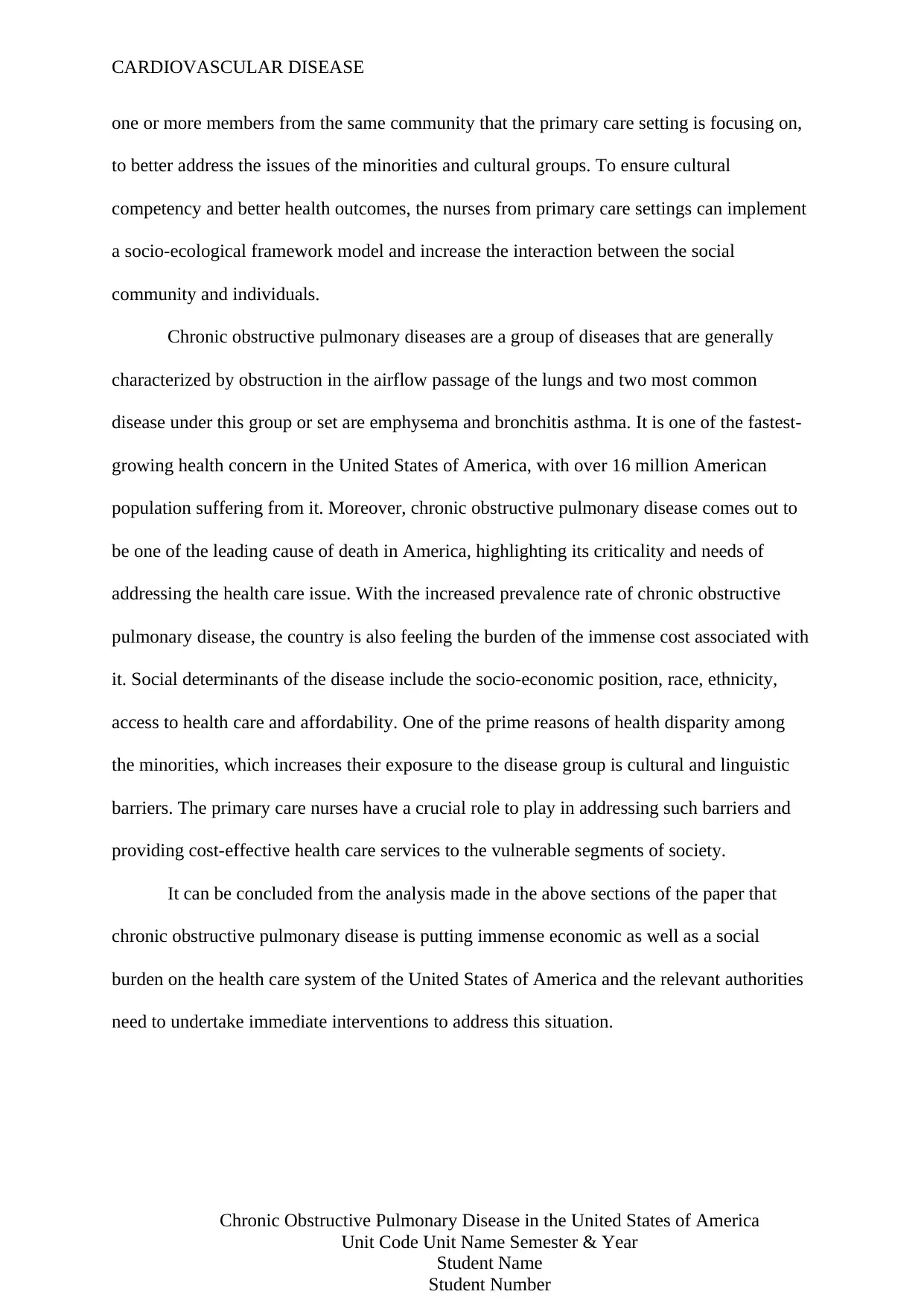
CARDIOVASCULAR DISEASE
one or more members from the same community that the primary care setting is focusing on,
to better address the issues of the minorities and cultural groups. To ensure cultural
competency and better health outcomes, the nurses from primary care settings can implement
a socio-ecological framework model and increase the interaction between the social
community and individuals.
Chronic obstructive pulmonary diseases are a group of diseases that are generally
characterized by obstruction in the airflow passage of the lungs and two most common
disease under this group or set are emphysema and bronchitis asthma. It is one of the fastest-
growing health concern in the United States of America, with over 16 million American
population suffering from it. Moreover, chronic obstructive pulmonary disease comes out to
be one of the leading cause of death in America, highlighting its criticality and needs of
addressing the health care issue. With the increased prevalence rate of chronic obstructive
pulmonary disease, the country is also feeling the burden of the immense cost associated with
it. Social determinants of the disease include the socio-economic position, race, ethnicity,
access to health care and affordability. One of the prime reasons of health disparity among
the minorities, which increases their exposure to the disease group is cultural and linguistic
barriers. The primary care nurses have a crucial role to play in addressing such barriers and
providing cost-effective health care services to the vulnerable segments of society.
It can be concluded from the analysis made in the above sections of the paper that
chronic obstructive pulmonary disease is putting immense economic as well as a social
burden on the health care system of the United States of America and the relevant authorities
need to undertake immediate interventions to address this situation.
Chronic Obstructive Pulmonary Disease in the United States of America
Unit Code Unit Name Semester & Year
Student Name
Student Number
one or more members from the same community that the primary care setting is focusing on,
to better address the issues of the minorities and cultural groups. To ensure cultural
competency and better health outcomes, the nurses from primary care settings can implement
a socio-ecological framework model and increase the interaction between the social
community and individuals.
Chronic obstructive pulmonary diseases are a group of diseases that are generally
characterized by obstruction in the airflow passage of the lungs and two most common
disease under this group or set are emphysema and bronchitis asthma. It is one of the fastest-
growing health concern in the United States of America, with over 16 million American
population suffering from it. Moreover, chronic obstructive pulmonary disease comes out to
be one of the leading cause of death in America, highlighting its criticality and needs of
addressing the health care issue. With the increased prevalence rate of chronic obstructive
pulmonary disease, the country is also feeling the burden of the immense cost associated with
it. Social determinants of the disease include the socio-economic position, race, ethnicity,
access to health care and affordability. One of the prime reasons of health disparity among
the minorities, which increases their exposure to the disease group is cultural and linguistic
barriers. The primary care nurses have a crucial role to play in addressing such barriers and
providing cost-effective health care services to the vulnerable segments of society.
It can be concluded from the analysis made in the above sections of the paper that
chronic obstructive pulmonary disease is putting immense economic as well as a social
burden on the health care system of the United States of America and the relevant authorities
need to undertake immediate interventions to address this situation.
Chronic Obstructive Pulmonary Disease in the United States of America
Unit Code Unit Name Semester & Year
Student Name
Student Number
⊘ This is a preview!⊘
Do you want full access?
Subscribe today to unlock all pages.

Trusted by 1+ million students worldwide
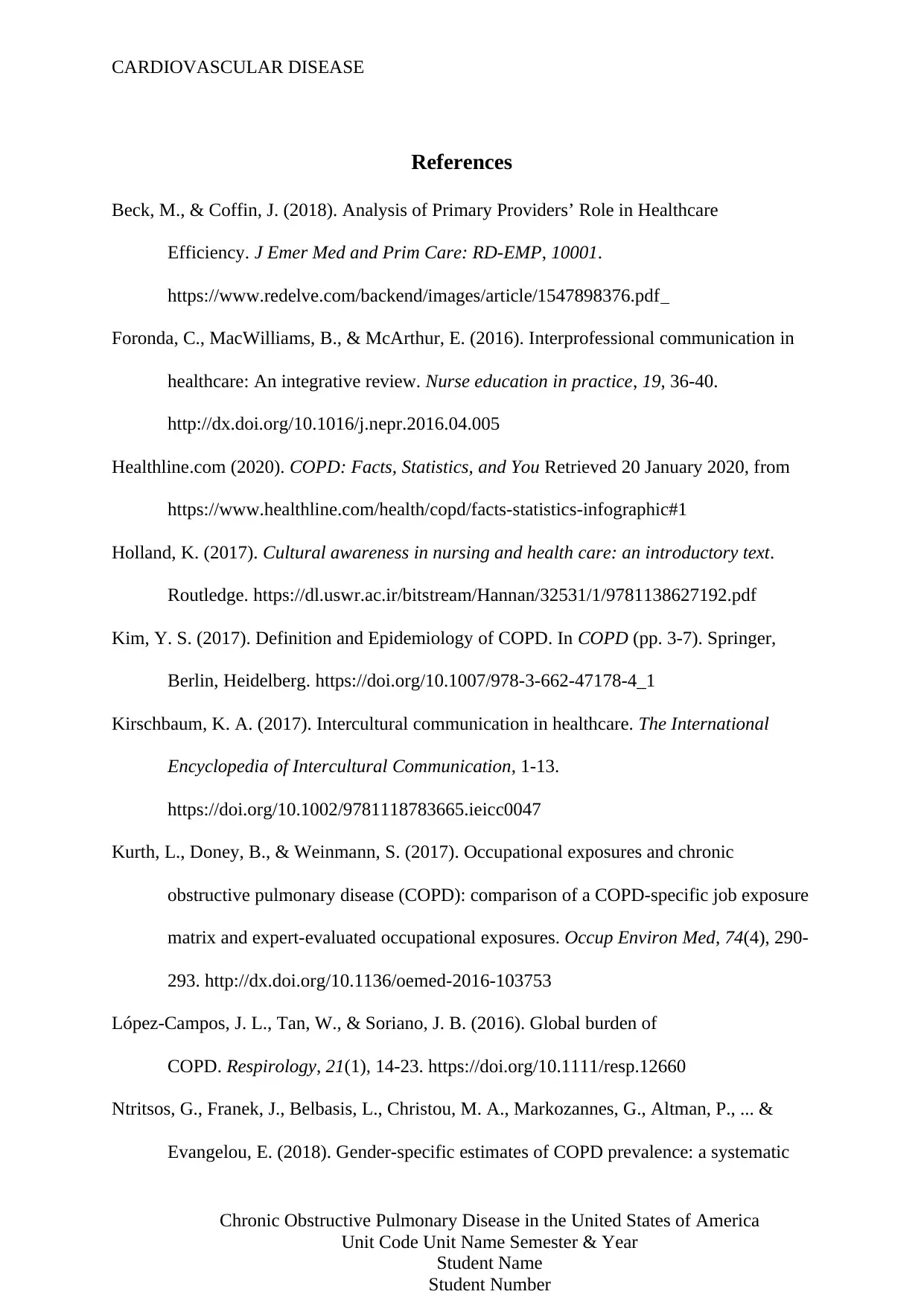
CARDIOVASCULAR DISEASE
References
Beck, M., & Coffin, J. (2018). Analysis of Primary Providers’ Role in Healthcare
Efficiency. J Emer Med and Prim Care: RD-EMP, 10001.
https://www.redelve.com/backend/images/article/1547898376.pdf
Foronda, C., MacWilliams, B., & McArthur, E. (2016). Interprofessional communication in
healthcare: An integrative review. Nurse education in practice, 19, 36-40.
http://dx.doi.org/10.1016/j.nepr.2016.04.005
Healthline.com (2020). COPD: Facts, Statistics, and You Retrieved 20 January 2020, from
https://www.healthline.com/health/copd/facts-statistics-infographic#1
Holland, K. (2017). Cultural awareness in nursing and health care: an introductory text.
Routledge. https://dl.uswr.ac.ir/bitstream/Hannan/32531/1/9781138627192.pdf
Kim, Y. S. (2017). Definition and Epidemiology of COPD. In COPD (pp. 3-7). Springer,
Berlin, Heidelberg. https://doi.org/10.1007/978-3-662-47178-4_1
Kirschbaum, K. A. (2017). Intercultural communication in healthcare. The International
Encyclopedia of Intercultural Communication, 1-13.
https://doi.org/10.1002/9781118783665.ieicc0047
Kurth, L., Doney, B., & Weinmann, S. (2017). Occupational exposures and chronic
obstructive pulmonary disease (COPD): comparison of a COPD-specific job exposure
matrix and expert-evaluated occupational exposures. Occup Environ Med, 74(4), 290-
293. http://dx.doi.org/10.1136/oemed-2016-103753
López‐Campos, J. L., Tan, W., & Soriano, J. B. (2016). Global burden of
COPD. Respirology, 21(1), 14-23. https://doi.org/10.1111/resp.12660
Ntritsos, G., Franek, J., Belbasis, L., Christou, M. A., Markozannes, G., Altman, P., ... &
Evangelou, E. (2018). Gender-specific estimates of COPD prevalence: a systematic
Chronic Obstructive Pulmonary Disease in the United States of America
Unit Code Unit Name Semester & Year
Student Name
Student Number
References
Beck, M., & Coffin, J. (2018). Analysis of Primary Providers’ Role in Healthcare
Efficiency. J Emer Med and Prim Care: RD-EMP, 10001.
https://www.redelve.com/backend/images/article/1547898376.pdf
Foronda, C., MacWilliams, B., & McArthur, E. (2016). Interprofessional communication in
healthcare: An integrative review. Nurse education in practice, 19, 36-40.
http://dx.doi.org/10.1016/j.nepr.2016.04.005
Healthline.com (2020). COPD: Facts, Statistics, and You Retrieved 20 January 2020, from
https://www.healthline.com/health/copd/facts-statistics-infographic#1
Holland, K. (2017). Cultural awareness in nursing and health care: an introductory text.
Routledge. https://dl.uswr.ac.ir/bitstream/Hannan/32531/1/9781138627192.pdf
Kim, Y. S. (2017). Definition and Epidemiology of COPD. In COPD (pp. 3-7). Springer,
Berlin, Heidelberg. https://doi.org/10.1007/978-3-662-47178-4_1
Kirschbaum, K. A. (2017). Intercultural communication in healthcare. The International
Encyclopedia of Intercultural Communication, 1-13.
https://doi.org/10.1002/9781118783665.ieicc0047
Kurth, L., Doney, B., & Weinmann, S. (2017). Occupational exposures and chronic
obstructive pulmonary disease (COPD): comparison of a COPD-specific job exposure
matrix and expert-evaluated occupational exposures. Occup Environ Med, 74(4), 290-
293. http://dx.doi.org/10.1136/oemed-2016-103753
López‐Campos, J. L., Tan, W., & Soriano, J. B. (2016). Global burden of
COPD. Respirology, 21(1), 14-23. https://doi.org/10.1111/resp.12660
Ntritsos, G., Franek, J., Belbasis, L., Christou, M. A., Markozannes, G., Altman, P., ... &
Evangelou, E. (2018). Gender-specific estimates of COPD prevalence: a systematic
Chronic Obstructive Pulmonary Disease in the United States of America
Unit Code Unit Name Semester & Year
Student Name
Student Number
Paraphrase This Document
Need a fresh take? Get an instant paraphrase of this document with our AI Paraphraser
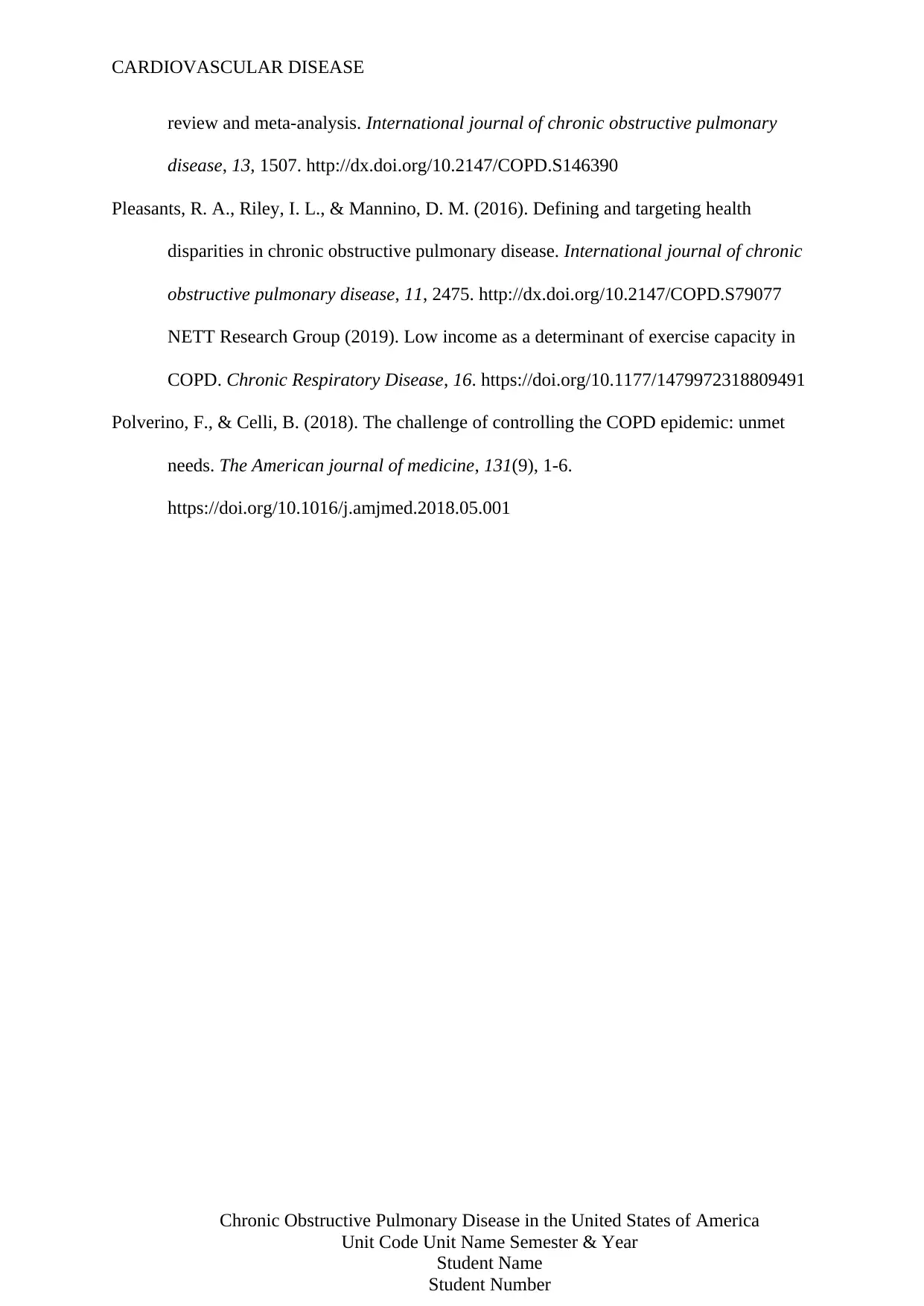
CARDIOVASCULAR DISEASE
review and meta-analysis. International journal of chronic obstructive pulmonary
disease, 13, 1507. http://dx.doi.org/10.2147/COPD.S146390
Pleasants, R. A., Riley, I. L., & Mannino, D. M. (2016). Defining and targeting health
disparities in chronic obstructive pulmonary disease. International journal of chronic
obstructive pulmonary disease, 11, 2475. http://dx.doi.org/10.2147/COPD.S79077
NETT Research Group (2019). Low income as a determinant of exercise capacity in
COPD. Chronic Respiratory Disease, 16. https://doi.org/10.1177/1479972318809491
Polverino, F., & Celli, B. (2018). The challenge of controlling the COPD epidemic: unmet
needs. The American journal of medicine, 131(9), 1-6.
https://doi.org/10.1016/j.amjmed.2018.05.001
Chronic Obstructive Pulmonary Disease in the United States of America
Unit Code Unit Name Semester & Year
Student Name
Student Number
review and meta-analysis. International journal of chronic obstructive pulmonary
disease, 13, 1507. http://dx.doi.org/10.2147/COPD.S146390
Pleasants, R. A., Riley, I. L., & Mannino, D. M. (2016). Defining and targeting health
disparities in chronic obstructive pulmonary disease. International journal of chronic
obstructive pulmonary disease, 11, 2475. http://dx.doi.org/10.2147/COPD.S79077
NETT Research Group (2019). Low income as a determinant of exercise capacity in
COPD. Chronic Respiratory Disease, 16. https://doi.org/10.1177/1479972318809491
Polverino, F., & Celli, B. (2018). The challenge of controlling the COPD epidemic: unmet
needs. The American journal of medicine, 131(9), 1-6.
https://doi.org/10.1016/j.amjmed.2018.05.001
Chronic Obstructive Pulmonary Disease in the United States of America
Unit Code Unit Name Semester & Year
Student Name
Student Number
1 out of 8
Related Documents
Your All-in-One AI-Powered Toolkit for Academic Success.
+13062052269
info@desklib.com
Available 24*7 on WhatsApp / Email
![[object Object]](/_next/static/media/star-bottom.7253800d.svg)
Unlock your academic potential
Copyright © 2020–2025 A2Z Services. All Rights Reserved. Developed and managed by ZUCOL.




